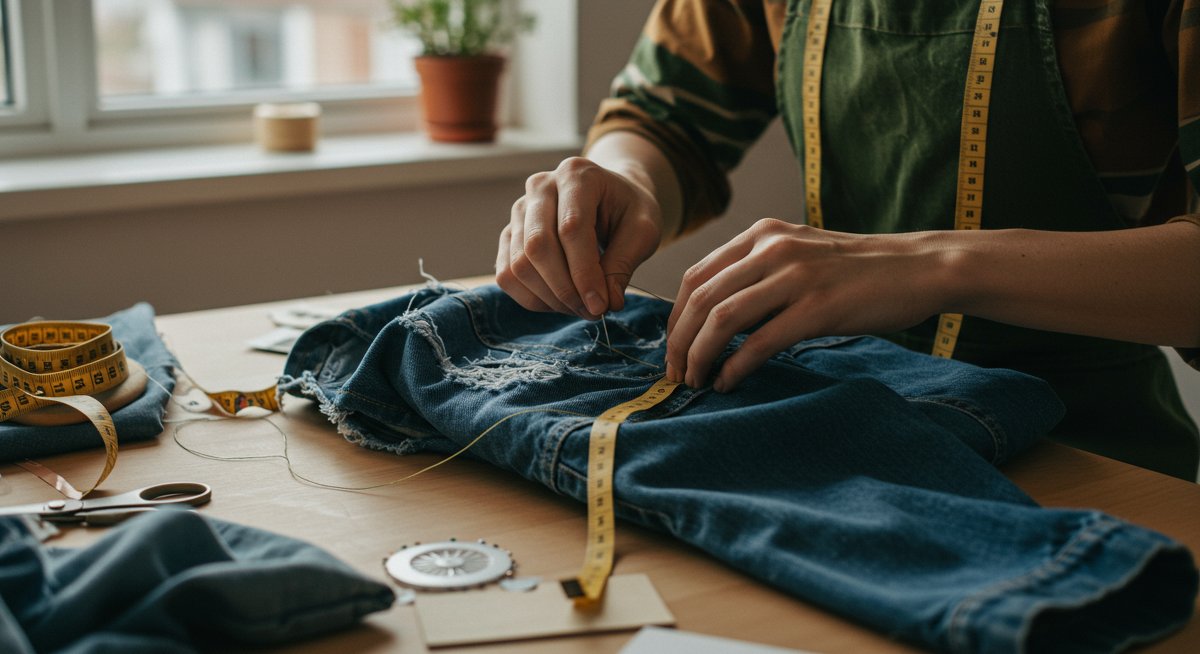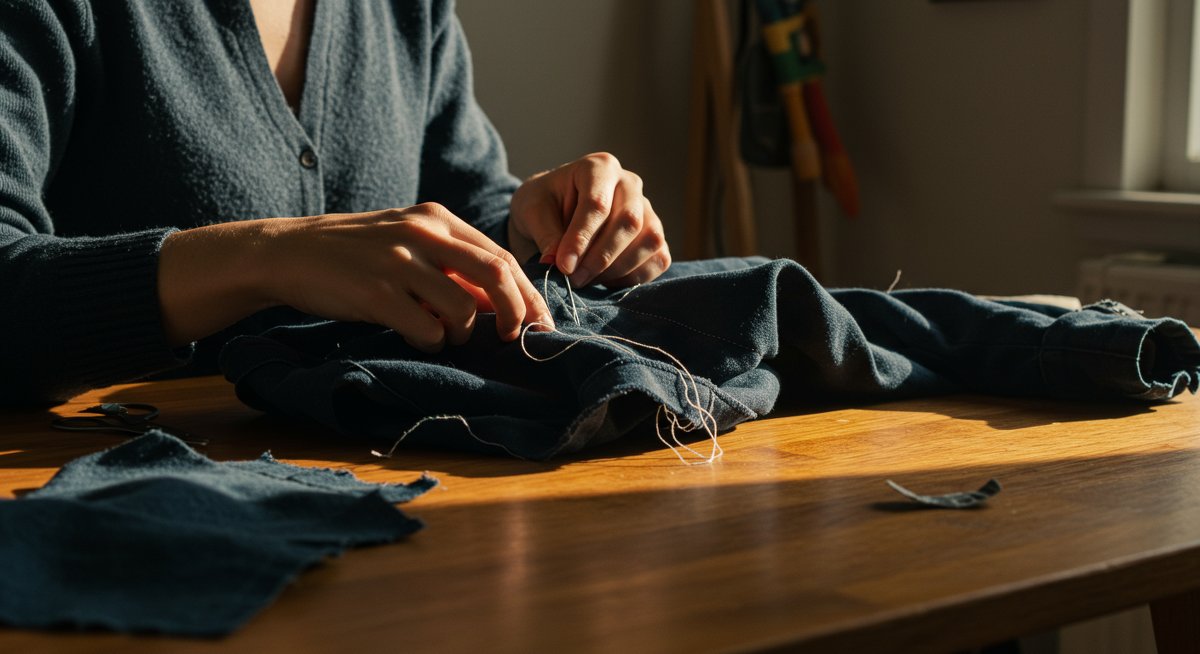Are you ready to give your wardrobe a sustainable makeover? In a world grappling with textile waste, upcycling clothes isn't just a trend; it's a powerful act of environmental responsibility. By transforming old garments into new treasures, you're not only reducing waste but also expressing your unique style in an eco-friendly way. This guide is your comprehensive resource for diving into the world of upcycling, offering practical tips, inspiring projects, and a deeper understanding of the positive impact you can make.

Deep Dive into Upcycling for Eco-Conscious Living
Upcycling, at its core, is the art of transforming unwanted items into something new and valuable. In the context of fashion, this means giving your old clothes a second life instead of sending them to a landfill. The fashion industry is a significant contributor to environmental pollution, and fast fashion encourages overconsumption and waste. Upcycling provides a creative and effective way to counteract these negative impacts. It's about embracing creativity, resourcefulness, and a commitment to a more sustainable lifestyle. This approach not only reduces waste but also conserves the resources used in producing new clothing, such as water, energy, and raw materials. The more we upcycle, the less we rely on the destructive practices of the fashion industry.
Example 1: Consider the impact of textile waste. The Ellen MacArthur Foundation estimates that a truckload of textiles is landfilled or burned every second. By upcycling, you're actively diverting textiles from this waste stream. For instance, turning an old t-shirt into reusable shopping bags prevents the need for new plastic bags, thus contributing to waste reduction.
Example 2: Think about the energy saved. Producing new clothing requires significant energy for manufacturing, transportation, and distribution. Upcycling, on the other hand, dramatically reduces this energy consumption. Refashioning an old pair of jeans into a stylish skirt, for example, saves the energy needed to produce a new garment from scratch.
Example 3: Let’s talk about water conservation. The fashion industry is a major consumer of water, especially for growing cotton and dyeing fabrics. Upcycling uses existing fabrics, thereby reducing the demand for water-intensive processes. By choosing to upcycle, you contribute to the responsible use of this precious resource.
Common Mistakes: A common mistake is feeling overwhelmed by complicated projects. Start small! Begin with simple alterations or repairs to build confidence and skills.
Expert Tip: Explore online communities and workshops for inspiration and skill-building. These platforms offer a wealth of ideas and support to fuel your upcycling journey.
Advanced Strategies and Insights
Beyond the basics, advanced upcycling involves more complex techniques and a deeper commitment to sustainable fashion. This includes understanding different fabric types, mastering advanced sewing skills, and exploring various design possibilities. It also involves sourcing materials responsibly and considering the entire lifecycle of your upcycled garments.
Example 1: One advanced strategy is fabric manipulation. This could involve techniques like patchwork, appliqué, or fabric dyeing to create unique designs. For instance, taking several old shirts and combining them through patchwork to create a quilt-like jacket transforms discarded items into wearable art. This showcases a high level of creativity and resourcefulness.
Example 2: Another advanced insight involves understanding fabric composition. Knowing the properties of different fabrics, like cotton, linen, or silk, allows you to choose the best materials for your projects. For example, upcycling silk scarves into a dress requires understanding the drape and texture of silk to create a stunning garment.
Example 3: Consider incorporating zero-waste design principles. This means planning your projects to minimize fabric scraps and waste. For example, designing a dress from a single piece of fabric, cutting strategically to use every part, showcases a commitment to sustainability and innovation. This approach pushes the boundaries of upcycling.
Common Mistakes: A common mistake is underestimating the importance of proper preparation. Always wash and iron fabrics before starting a project to ensure the final product is durable and wearable.
Expert Tip: Experiment with different design software or sketching to visualize your upcycling projects. This helps you plan the transformation and avoid mistakes during the process.

Optimizing Your Sustainable Wardrobe
To optimize your sustainable wardrobe, start by assessing what you already own. Identify items that can be upcycled, repaired, or repurposed. This initial step helps to avoid impulse purchases and ensures that you're making the most of what you have. The goal is to create a versatile, durable, and stylish wardrobe that aligns with your values and reduces your environmental impact. The key is to focus on quality over quantity and to embrace a mindful approach to fashion.
Example 1: Organize a clothing swap with friends or family. Swapping clothes is a fun and effective way to refresh your wardrobe without buying anything new. This also helps to extend the lifespan of clothing items that might otherwise be discarded. By exchanging garments, you foster a sense of community and share your commitment to sustainable fashion.
Example 2: Learn basic repair techniques, such as mending, patching, and replacing buttons. These skills are essential for extending the life of your clothing and preventing it from ending up in landfills. For instance, a small tear in your jeans can be easily mended with a decorative patch, transforming a problem into a unique design feature.
Example 3: Choose versatile pieces that can be mixed and matched. Select classic items that can be styled in different ways to create various outfits. This strategy reduces the need for frequent purchases and promotes a more sustainable approach to fashion. A well-chosen capsule wardrobe can be incredibly stylish and eco-friendly.
Common Mistakes: A common mistake is not properly caring for your upcycled items. Follow care instructions to ensure they last as long as possible.
Expert Tip: Use eco-friendly detergents and avoid harsh chemicals when washing your upcycled clothes to further minimize environmental impact.
Scaling Your Impact: Beyond Personal Choices
While personal upcycling projects are valuable, you can amplify your impact by participating in the broader sustainable fashion movement. This could involve supporting ethical brands, advocating for policy changes, and educating others about the benefits of upcycling and sustainable practices. Your choices can influence the industry and inspire others to adopt more responsible consumption habits.
Example 1: Advocate for sustainable fashion policies in your community. Support initiatives that promote textile recycling, reduce waste, and encourage responsible manufacturing practices. Reach out to local representatives and voice your support for eco-friendly legislation. This will make a difference at a larger scale.
Example 2: Support and promote ethical brands that prioritize fair labor practices, sustainable materials, and transparent supply chains. Purchasing from these businesses helps drive demand for more sustainable products and encourages other companies to adopt responsible practices. By supporting ethical businesses, you contribute to a more equitable and sustainable fashion industry.
Example 3: Educate others about the benefits of upcycling. Share your projects, skills, and knowledge through social media, workshops, or community events. Inspire others to join the upcycling movement and embrace sustainable fashion. Your enthusiasm can create a ripple effect, motivating others to make positive changes.
Common Mistakes: A common mistake is thinking that one person's actions don't make a difference. Every upcycled garment, every repaired item, and every sustainable choice adds up to a significant collective impact.
Expert Tip: Consider starting a local upcycling group or workshop to share knowledge, skills, and resources. This creates a supportive community and encourages collaboration.
Expert-Level Green Living Insights
Achieving expert-level green living in the context of upcycling involves a deep understanding of the fashion industry's impact and a commitment to pushing the boundaries of sustainable practices. It includes mastering advanced techniques, staying informed about the latest innovations, and actively participating in shaping the future of sustainable fashion. This level of engagement not only reduces your environmental footprint but also inspires others and contributes to a more circular economy.
Example 1: Develop expertise in fabric dyeing and printing techniques. This allows you to transform old fabrics into unique, customized designs. Experiment with natural dyes, such as those made from plants, to minimize the use of harmful chemicals. By mastering these skills, you can further reduce the environmental impact of your creations.
Example 2: Stay informed about new materials and technologies. Follow industry trends and explore innovative fabrics made from sustainable sources. For instance, learn about materials derived from recycled plastic or agricultural waste. Integrating these new materials into your upcycling projects allows you to contribute to a more circular economy.
Example 3: Collaborate with other designers and artists. Working with professionals in the field can broaden your perspectives and increase your reach. By participating in collaborative projects, you can promote your work, share knowledge, and contribute to a larger movement. Building professional relationships can provide support and inspiration for your upcycling journey.
Common Mistakes: A common mistake is not continuously seeking knowledge and refining skills. The field of sustainable fashion is constantly evolving; staying informed is critical.
Expert Tip: Consider starting an online platform or blog to showcase your work and share your expertise. This can help you build a community and establish yourself as a leader in sustainable fashion.